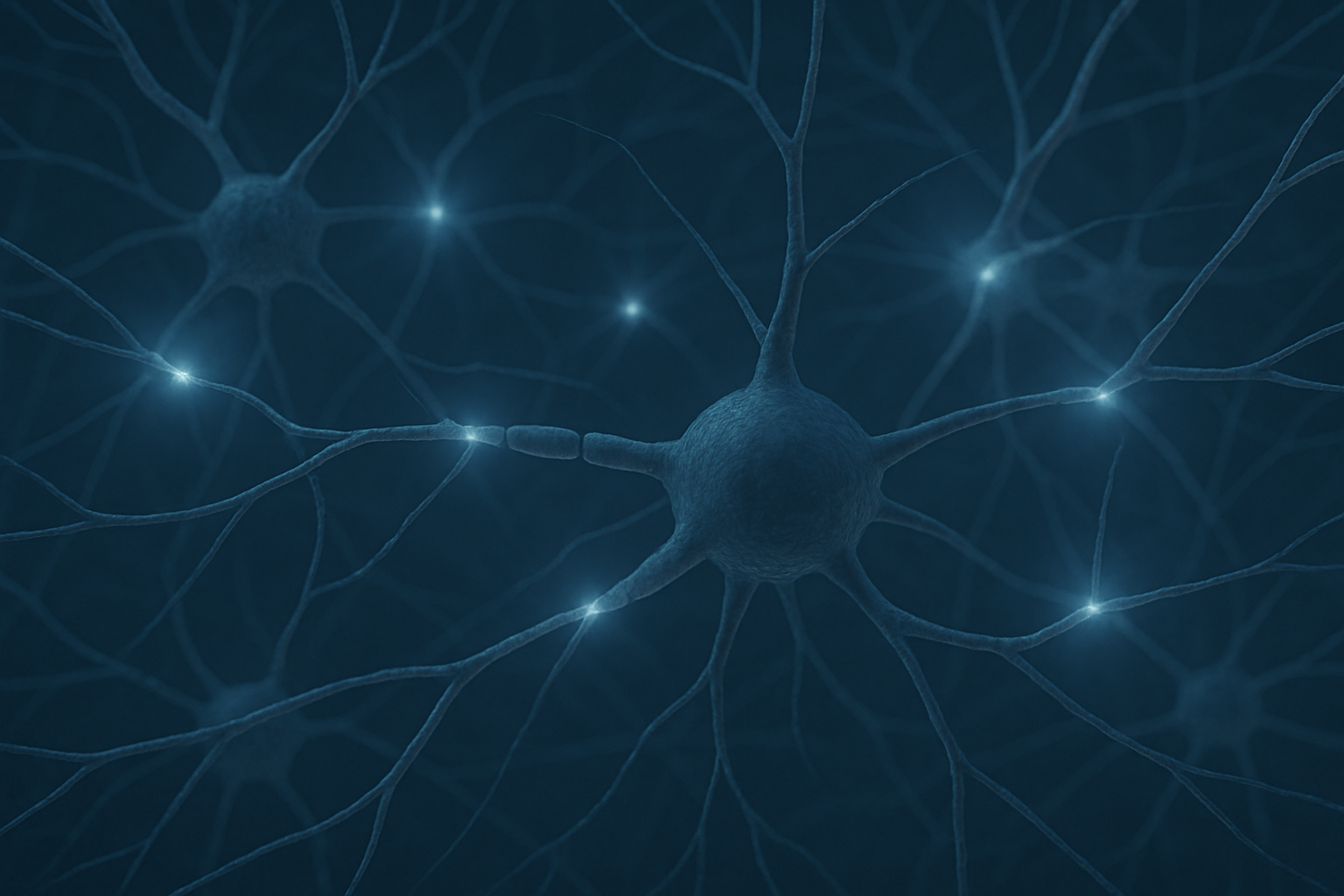
Curiosity is a gift.
Pain isn’t just a signal. It’s a story. And you’re here because you know there’s more to it than symptoms and scans.
Let’s explore how meaning, memory, and movement shape that story.

Not Just a Signal
-
Pain is not a direct readout of tissue damage, it’s a complex output shaped by your brain’s interpretation of threat.
Beliefs about pain can amplify or ease your experience. If you’ve been told your spine is fragile or your body is “out of alignment,” that belief alone can increase pain intensity (Darlow et al., 2013).
Life experiences, such as prior injuries, surgeries, or trauma, create memories that the nervous system uses to predict and protect. The more sensitized your system is by the past, the more likely it is to overreact in the present (Moseley, 2003).
Fear can create a vicious cycle. Fear of movement (kinesiophobia) or fear of reinjury has been linked to worse pain outcomes and higher disability (Vlaeyen & Linton, 2000).
Pain is real—but it’s not always a sign of danger. It’s a response shaped by your beliefs, history, emotions, and nervous system’s best guess about what’s going on.
This is the essence of the biopsychosocial model of pain—a model that sees pain not just as a symptom, but as a lived experience influenced by biology, psychology, and social context.
To heal, we must go beyond fixing tissues. We must also update the stories our nervous systems tell.
References:
Darlow B, et al. (2013). Beliefs about back pain: The influence of public and private messages. European Journal of Pain.
Moseley GL. (2003). Joining forces—combining cognitive and physical therapy for chronic pain: A narrative review. Clinical Rehabilitation.
Vlaeyen JWS, Linton SJ. (2000). Fear-avoidance and its consequences in chronic musculoskeletal pain. Pain.
-
What something means to you can shape how it feels, sometimes more than the treatment itself.
Two people can have the same injury but experience wildly different pain levels. Why? Because the brain isn’t just measuring tissue, it’s measuring threat, context, and significance. If pain is interpreted as a sign of permanent damage, it’s more likely to persist. If it’s seen as a temporary signal that makes sense, it often fades faster.
In one study, patients recovering from spinal surgery were given either morphine or a saline placebo, but those who knew they were getting a painkiller reported greater relief than those who didn’t, even when the dose was identical (Benedetti et al., 2003). Belief changed biology.
This is not just “placebo effect.” It’s the power of meaning—the story your brain tells itself about what’s happening (Tracey, 2010). Whether it’s a diagnosis, a scan, a word from a doctor, or a cultural belief, meaning acts like a filter between sensation and suffering.
Clinically, this means how we frame pain matters. Telling someone “your spine is degenerating” versus “this is a common finding with aging and movement is safe” can produce totally different outcomes (Moseley, 2008), even if X-ray results were the same.
Medicine treats tissues. Meaning treats perception. Both are powerful. But one can amplify the other—or work against it.
References:
Benedetti F, et al. (2003). Neurobiological mechanisms of the placebo effect. Journal of Neuroscience.
Tracey I. (2010). Getting the pain you expect: mechanisms of placebo, nocebo and reappraisal effects in humans. Nature Medicine.
Moseley GL. (2008). Reconceptualising pain according to modern pain science. Physical Therapy Reviews.
-
Pain doesn’t just hurt, it speaks. And how we answer back shapes what we feel next.
If you’ve ever thought, “Something must be seriously wrong,” during a painful moment, you’ve felt this in action. The brain doesn’t just receive pain signals, it interprets them. It asks: What does this mean? Am I safe? Have I been here before? That interpretation becomes part of the pain itself.
The words we use—“my back is broken,” “my knees are shot,” “I’m falling apart”—aren’t just metaphors. They reinforce fear, fragility, and a sense of doom that can make pain worse and recovery slower. On the other hand, when we understand pain as a protective message, not a damage report, we begin to experience it differently.
This is the brain’s storytelling instinct at work. And it’s powerful.
Research has shown that how we explain pain can actually change how much we feel. One study found that when people were educated about how pain works (called pain neuroscience education), they not only reported less fear, but also moved better and felt less pain overall (Louw et al., 2016).
Change the story, and you often change the experience.
Reference:
Louw A, et al. (2016). The efficacy of pain neuroscience education on musculoskeletal pain: A systematic review of the literature. Physiotherapy Theory and Practice.
-
Pain isn’t just happening in a body—it’s happening to a person.
Every sensation we call “pain” comes with a story: Who is this happening to? What does it mean? What have they been through? What do they believe about it? You can’t fully understand pain without understanding the person carrying it.
Pain is shaped by mood, memory, stress, support, and context. A stubbed toe feels different when you’re laughing with friends versus when you’re grieving a loss. A sore back means something else to someone who’s afraid of losing their job, or who’s lived through chronic illness.
That’s why a scan or diagnosis can never tell the whole story. Two people can have the same injury but completely different experiences of pain (Gatchel et al., 2007), because pain is not just a signal from the body. It’s an experience constructed by the brain, filtered through emotion, belief, and meaning.
This is the heart of the biopsychosocial model of pain: biology matters, but so does psychology and social context.
To treat pain well, we must see the person—not just the symptom.
Reference:
Gatchel RJ, et al. (2007). The biopsychosocial approach to chronic pain: Scientific advances and future directions. Psychological Bulletin.
Feed your curiosity. Question the old models. Follow what resonates.

New Lenses: Rethinking Pain Through Wonder
-
Pain isn’t just a reaction, it’s a recognition.
Your nervous system is constantly scanning for patterns: What’s familiar? What’s changed? What has led to trouble before? When it senses something that resembles a past threat—whether physical, emotional, or situational—it may trigger pain, even if there’s no current damage.
This is why pain can show up during stress, certain movements, or even in specific places, your system isn’t responding to what is, but to what it predicts.
It’s like a smoke alarm that sometimes goes off because it remembers a fire, not because there’s one now.
Researchers have described this as the brain’s “predictive processing” model, your brain uses past experiences to make sense of new sensations (Wiech, 2016). Pain, then, becomes a protective pattern, not a perfect measurement.
This helps explain why pain can linger even after tissues have healed. Or why two people can experience the same injury, yet one recovers quickly while the other develops chronic pain. It’s not just about the injury, it’s about the pattern your brain thinks it sees.
Understanding pain as a pattern detector helps us move away from fear and toward curiosity. The goal isn’t to fight the alarm, it’s to teach the system it’s safe again.
Reference:
Wiech K. (2016). Deconstructing the sensation of pain: The influence of cognitive processes on pain perception. Science.
-
Pain isn’t a flaw in the system—it is the system adapting.
At its core, pain is a protective function. It helps us pause, avoid harm, and heal. But it doesn’t stop there. Pain adapts to your environment, your habits, your beliefs, and your history. It learns.
The more your system is exposed to threat—real or perceived—the more sensitive it can become. This is called central sensitization (Woolf, 2011), and it’s not a malfunction. It’s your nervous system doing what it was designed to do: protect you, even if it sometimes overshoots.
Think of it like calluses for the nervous system. Just as your skin toughens to repeated friction, your pain system becomes more responsive to repeated threat.
This is why chronic pain isn’t “all in your head”, it’s in your system. And the system can change.
Movement, education, safety, support—these don’t just make you feel better; they retrain the nervous system to downregulate its alarm (Nijs et al., 2014). Healing happens not by silencing pain, but by updating the system’s understanding of what is safe.
Pain is plastic. That means it’s not fixed. And that means change is possible.
References:
Woolf CJ. (2011). Central sensitization: Implications for the diagnosis and treatment of pain. Pain.
Nijs J, et al. (2014). Treatment of central sensitization in patients with ‘unexplained’ chronic pain: What options do we have? Expert Opinion on Pharmacotherapy.
-
Pain isn’t your body failing—it’s your body communicating.
We often think of pain as a problem to get rid of. But what if we treated it like a message instead of a malfunction?
Pain is how your body says, “Something needs attention.” Sometimes that something is physical, like an injury. But other times, it’s deeper: stress, fear, exhaustion, unmet needs, or old emotional wounds. Pain doesn’t always point to damage. Sometimes, it points to imbalance.
Ignoring pain, numbing it, or fighting it blindly can drown out important signals. But listening to pain, really listening, can reveal what your system is trying to protect you from, or prepare you for.
Modern pain science shows us that pain is not just a bottom-up sensation, but a top-down interpretation. It’s your nervous system doing its job: keeping you safe in a world that’s always changing (Melzack & Katz, 2013).
That doesn’t mean pain is always accurate, but it’s always worth being curious about.
Pain is not the enemy. It’s a messenger. And messengers aren’t meant to be silenced, they’re meant to be understood.
Reference:
Melzack R, Katz J. (2013). Pain. Wiley Interdisciplinary Reviews: Cognitive Science.
-
We’re taught to see pain as a warning sign. But what if it’s also an invitation?
Pain doesn’t always mean something is broken. Sometimes, it means something is changing. Like sore muscles after a workout, heartbreak after loss, or growing pains in adolescence—pain often shows up at the edges of transformation.
That doesn’t make it pleasant. But it does make it meaningful.
Research in neuroscience and psychology has shown that the nervous system uses pain not just to protect, but to teach. It helps us set boundaries, build resilience, and tune into what matters (Karos et al., 2018). Pain can motivate us to slow down, to seek help, to reconsider our choices—and sometimes, to move through hard truths toward healing.
Growth often hurts. But not all hurt is harmful.
When we stop treating pain as the enemy, we can start to ask: What is this trying to show me?
That question alone can shift our relationship with pain, from fear to understanding, from avoidance to agency.
Pain may mark the limits of comfort, but it can also be the beginning of change.
Reference:
Karos K, et al. (2018). The social pain model: Understanding the role of social context in pain. PAIN.
Wondering is not weakness—it’s how insight begins.

Wondering Through Pain: A Companion for Curiosity
This isn’t a checklist. It’s a conversation.
This toolkit is for those who are done with quick fixes and ready to explore. Not just the pain — but the meaning behind it. Use it to reflect, reframe, and rediscover your inner framework for healing.
🔍 Curiosity Prompts
What assumptions am I making about this pain?
What might this pain be trying to protect me from?
If pain is a story, whose voice is shaping it?
What would happen if I stopped trying to fight the pain — and started listening to it?
What changes when I ask: “What else could this mean?”
🌀 Reframe Builder
Default Story ➤ Wondering Reframe
“I don’t know what this means.” ➤ “What might this be pointing to?”
“This doesn’t make sense.” ➤ “What might this make possible?”
“Something must be wrong.” ➤ “Something might be adapting.”
“Pain means I have to stop.” ➤ “Pain might be asking me to move differently.”
🧠 Reflective Models
Pain as Pattern Detector – What’s repeating? When does pain show up? What sets it off or calms it?
Pain as Prediction – Could your body be overpredicting danger based on past experiences?
Pain as Protection – What is your system trying to guard against? Is that still needed?
Pain as Messenger – What’s the deeper signal beneath the sensation?
🌱 Micro-Wonders (Small Experiments)
Write a pain memory and reframe it with hindsight.
Sit in silence with discomfort for 5 minutes. Ask it a question, then just notice.
Move in a new way and narrate it with compassion: “I’m safe. I’m exploring.”
Speak to your pain like a protective friend: “I know you’re trying to help.”
💬 Wonder Quotes
“Curiosity didn’t kill the cat. It made it conscious.”
“Wondering is not weakness — it’s how insight begins.”
“The body remembers. Wonder reminds.”
“Pain isn’t a problem to erase. It’s a question to lean into.”
Use this toolkit anytime the old models feel too small. Wonder has room for you.

Wondering Insights
Pain Is Shaped by Belief, Experience, and Fear
Meaning Changes Perception
The Story Shapes the Experience
Understanding the Person in Pain

Start a Conversation with
Pain Ally
What if you could talk with your pain — and it talked back with insight, not fear?
Pain Ally helps you do just that.
It’s an interactive companion that blends pain science, story, and self-reflection — helping you see your pain in new ways.
Chat with
Pain Ally
App



